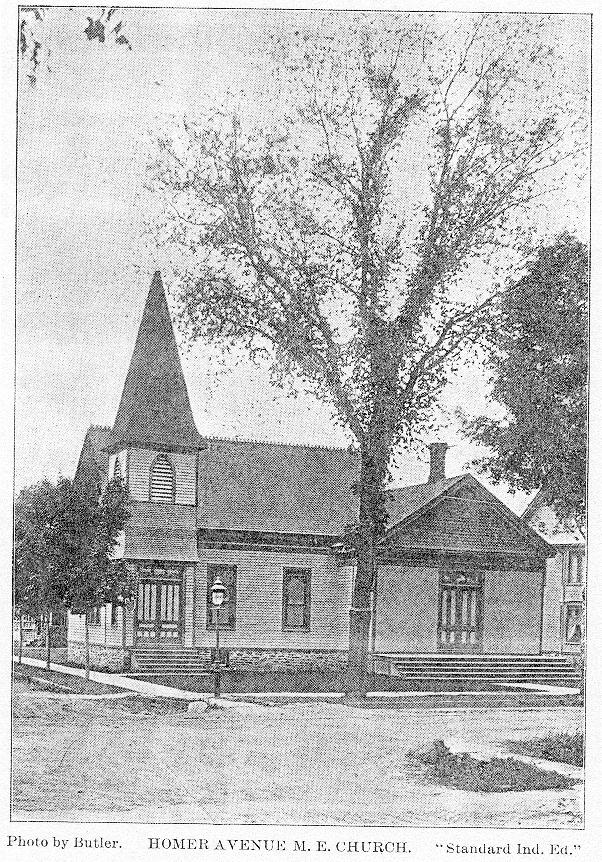
The Homer Avenue M. E. Church is the loving and the beloved child of the First M. E. church of Cortland, N. Y. Jan. 28, 1889, the official board of that society met and selected Rev. Geo. P. Avery, C. B. Hitchcock, A. L. Cole, H. M. Kellogg, A. Sager, Dr. E. B. Nash and Prosper Palmer to secure a site for a mission chapel; and they fixed upon a vacant lot on the corner of Homer and Maple avenues, the property of Thomas Ellsworth, which at a special meeting Feb. 11, 1889, was purchased for $1,500, subject to a mortgage of $1,100 held by E. A. Fish. At a meeting held April 20, 1890, a committee submitted a report with plans for a building 26 x 60 ft., the cost of which was decided to be too large to be raised at that time. On April 28, 1890, H. M. Kellogg reported having secured an option on the purchase of the old Presbyterian session house, offered for $400. The trustees secured the property and the work of removing the building to the site selected was reported completed on July 21, 1890. The stone for the walls, and the grading of the grounds were donated by several parties.

The foundation walls were laid free of charge by the Masons & Bricklayers' Union. At the Fourth Quarterly Conference, Sept. 15, 1890, Presiding Elder U. S. Beebe in the chair, a resolution was passed to organize the Mission Church of the second ward into a Second Methodist Episcopal Society, and A. Sager, Eli Stafford and Bloom LaBarre were selected to canvass the ward for a probable membership. At a special meeting held Sept. 29, 1890, a resolution was adopted "That the new society pay one seventh or $228 of the debt now incurred on account of the mission and that the First church pay the balance." Messrs. S. E. Curtis, F. L. Bosworth, A. Sager and Bloom LaBarre reported to an informal meeting held in the chapel Oct. 6, 1890, Major A. Sager presiding, and F. L. Bosworth acting as secretary, that ninety-one names were enrolled as probable members of the new society. At this meeting it was decided to name the church "The Homer Avenue Methodist Episcopal Church." A committee consisting of C. B. Hitchcock, Aaron Sager and Wm. B. Stoppard was appointed to attend the Conference then in session at Oneida and represent the society in securing a pastor. They were unanimous and importune in requesting the appointment of Charles E. Hamilton to the new charge. Their request was granted, and Mr. Hamilton began a most successful pastorate of five years. Mr. Hamilton was followed by M. J. Wells, who had just closed a very successful pastorate at Canastota where he had built a very fine and commodious parsonage. Mr. Wells remained but one year during which time he remodeled and enlarged the parsonage and greatly endeared himself to the people. E. B. Gearhart became the next pastor of the church and remained only one year. He was followed by J. C. B. Moyer who is now serving the church for the third year.
William Jameson Mantanye was born at Freetown, Cortland county, New York, October 17, 1843, and was a son of William Mantanye who then carried on a wagon factory at that place, but later on changed to mercantile pursuits and was for many years before and during the Civil War supervisor of his town. His mother was Betsey Fuller, daughter of Eleazer Fuller, who came from Monson, Massachusetts, in 1810, and settled upon one hundred acres about a mile north of Freetown Corners, purchased by him by contract of Nicholas Fish of New York, the deed being given in 1815. First living in a log house, Squire Fuller made out of the forest the best farm in Freetown and built the finest house in the town---a large two-story mansion, later owned by Chauncey Tuttle and thence known as the "Tuttle farm." William J. Mantanye attended the district school at Freetown and after he was 12 years old worked on a farm every summer. In the fall of 1859 and again in 1860 he attended the Homer academy. In the winter of 1860-61 he taught school in one of the lumbering districts on the north fork of the Conanesque, near Westfield, Tioga Co., Penn. On the first call for three-year troops he enlisted in Co. D, 76th N. Y. Infantry, and served through the war at the front in the Army of the Potomac. He was wounded at second Bull Run Aug. 29, 1862, but not seriously and returned to his regiment next day. At Gettysburg he was taken prisoner July 1, 1863, and paroled on the field July 4, but as the government held the parole to be illegal he soon after returned to his company without exchange. In the fall of 1863 he was called to Washington to take a commission in the 1st regiment of United States colored troops then being organized, but being then only 19 years of age he declined. In January, 1864, he re-enlisted as a veteran volunteer in his old company and regiment and in Oct. 1864, upon the expiration of the term of the regiment he was transferred to the 147th N. Y., thence to the 91st N. Y., from which he was discharged July 3, 1865. Thus he served first, in the first army corps under Reynolds and Doubleday until that corps was annihilated at Gettysburg. After that he served in the fifth corps of which the remnant of the old first corps was made the third division, and he was present in the last campaign and at the surrender of Lee April 9, 1865. On his return from the army in 1865 Mr. Mantanye came to Cortland where his father had taken up his residence that year. He entered on the study of law with Hon. Arthur Holmes, then one of the leading lawyers and politicians of the county. In May, 1867, he was admitted to the bar at Binghamton, beginning the practice of law soon after and continuing it ever since.
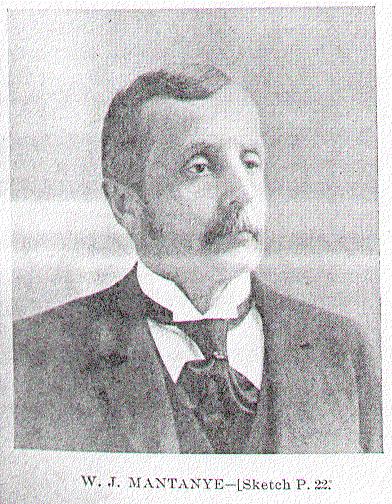
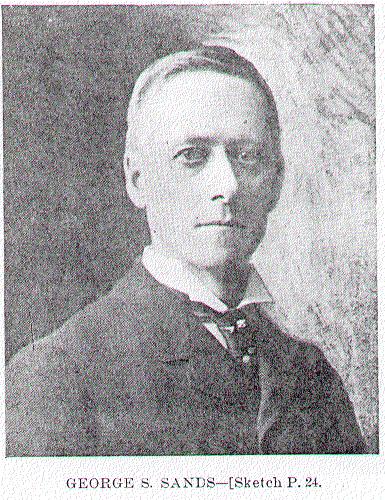
In May, 1869, he opened a law office at Marathon where he practiced until the spring of 1888, when he removed to Cortland, which has ever since been his residence. In 1872 Mr. Mantanye married Emma, the oldest daughter of David C. Cloyes, a prominent merchant of Cortland. They have one child, a daughter, Fanny. Mr. Mantanye has been a steadfast Republican all his life. After the war he was active in the party, being frequently a delegate to State conventions and a member of the Republican county committee. In 1882-3 he was a member of the Republican State committee for the Onandaga-Cortland district and of the executive committee of the State organization. In 1893 he was elected as delegate to the Constitutional Convention of 1894 from the 25th Senate District, then composed of Cortland, Broome, Tioga, Chenango and Delaware counties. In that convention he was a member of the important committees on powers and duties of the Legislature and on county and town officers. He introduced some important amendments which were adopted and two which were defeated. One of the latter was to make the term of office of Governor and Lieutenant-Governor four years and make them ineligible to election for the next succeeding term. The other was a provision for biennial sessions of the Legislature, which was on the suggestion of Gov. Black, introduced in the Legislature and passed but failed in the Legislature of 1899. He also advocated the amendment as to employment of convicts in penal institutions, forbidding their labor being sold out to contractors, and it was adopted. In June, 1895, Mr. Mantanye was appointed by Gov. Morton as a member of the Commission of Prisons created by the constitution of 1894, and was made chairman of the Committee on Annual Report in which position he has since been continued. He was also put upon the Committee of Legislation which had charge of the drafting and introduction in the Legislature of the proposed laws known as Chapter 429 of the Laws of 1896, which were enacted and have since been carried into the general revision of the prison laws. By these laws the taking of convicts from without the State by penitentiaries to board was ended, and it is now required that felons be sent to the reformatory and State prisons, and misdemeanants only to the jails and penitentiaries. The labor of convicts is also to be utilized in producing supplies for the public institutions of the State. The system has proved successful and is being adopted in other States. He is a member of the Tioughnioga Club and of the Union Veteran Legion and was the Colonel of the latter organization during the first two years of its organization.
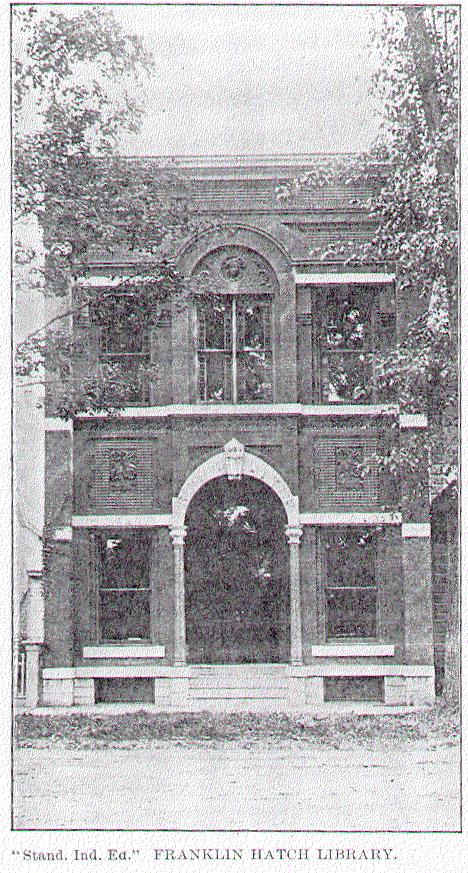
George S. Sands, member of assembly from Cortland county 1899 and 1900, is a native of Delaware county, born in the town of Middletown, Aug. 19, 1849. His father, George H. Sands, was interested in large farming properties and conducted a general country store and postoffice at Middletown, which was the headquarters for people for miles around. Until the family moved to Cortland, in April, 1867, the former divided his time between employment on the farm and attending school, during which time he was a student a the Andes Collegiate institute and the Delaware academy at Delhi, in which village he enjoys a large acquaintanceship. In 1867-68 he attended the Cortlandville academy and in the winter of 1868-69 he was employed in the First National bank, giving his services in exchange for the practical instruction and the experience he received as an accountant. At the opening of the Normal school in this village he was enrolled as a student and he pursued the regular English course there until May, 1870, when he entered the law office of M. M. Waters where he studied law until admitted to the bar at Schenectady, November, 1873. During vacation in 1869 he was employed in the large store of James S. Squires & Co. In 1873 he was elected town clerk, which office he held two years and in 1876 he was elected justice of the peace, being re-elected in 1880 and serving in that position six years. He resigned in 1883 to enable him to give his entire attention to the practice of law. Mr. Sands has always been a Republican. In 1896 he was prominently mentioned as one of the candidates for the Republican nomination for justice of the supreme court in the sixth judicial district. Mr. Sands reluctantly accepted the nomination for member of assembly at the hands of the regular Republican county convention in the fall of 1898 when the party was agitated by factional differences, and was elected in a strong Republican county by a somewhat reduced majority. But in the following year, being accorded a renomination in recognition of his services as a fair and conservative legislator, and in consideration of the further fact that it has usually been the custom to return to Albany a satisfactory representative, he received approximately the normal vote of his party. In the legislature of 1899 (that of 1900 is organizing as this Souvenir goes to press) he supported all party measures, although exercising a degree of independence on some very important bills upon which caucus action was not taken. As a member of the committee on codes, claims and federal relations he was required to devote much of his time to the preliminary examination of proposed laws and he became known as one of the few who gave to such work conscientious attention. Codes committee stands fourth in the list of important committees of the house. Mr. Sands is a member of the Masonic lodge and chapter, having been master of the lodge several terms, as well as assistant grand lecturer in this district. He is a member of the Tioughnioga club. His mother was left a widow when he was young and before coming to Cortland she married Mr. Chauncey Keator. She survives her second husband and with her son, Mr. G. S. Sands, and one daughter, Ella J. Sands, lives at a pleasant home on Main street. Another daughter, Mrs. W. J. Walker, died while a resident of the far west. The third daughter, Mrs. Clark Olds, the wife of a lawyer, has her home at Erie, Pa.
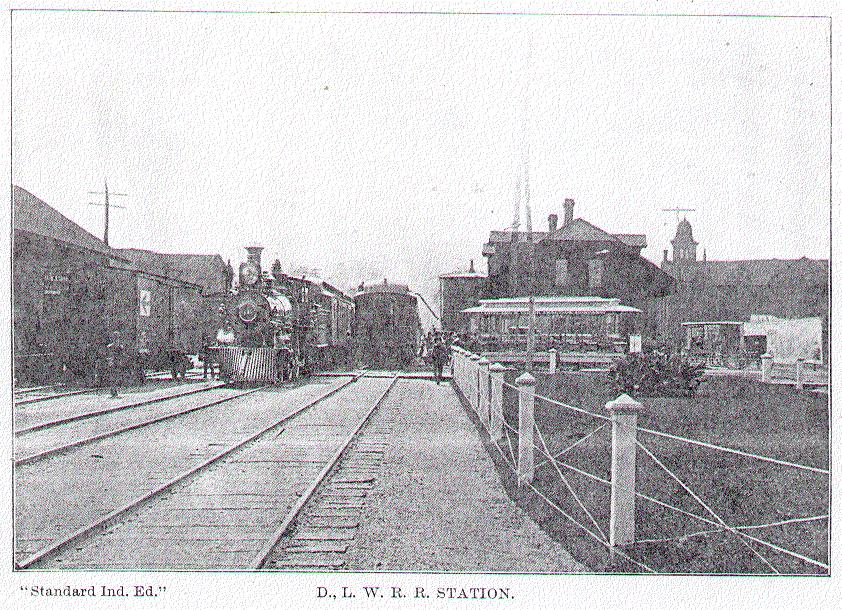
The Baraca Bible Class is a branch of the Baraca Union of America, an organization less than two years old yet having a membership of over 25,000 in the United States. The word Baraca means "Blessing" or "Valley of Blessing" and the local class aims to be a blessing to all who come within the radius of its influence. One of the difficult problems in bible study is how to get and keep men interested in Sunday-school work. The Baraca class does this. While it is a part of the school it yet has its distinctive work. It has a constitution and by-laws, officers, committees and teacher, also a class pin and colors.
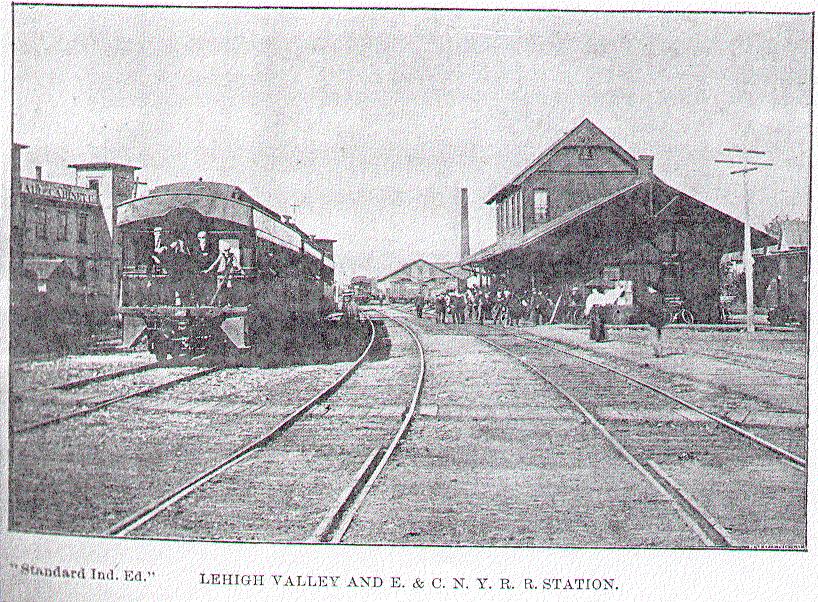
First Congregational Church.---On the 10th day of November, 1881, a council convened to consider the advisability of such a church and if thought best to aid in its formation, and found that one hundred and sixteen persons were enrolled and present for organization, and that a Sunday-school was organized with 171 enrolled members, including a class of 30 young men. The organization was completed and the first services were held in the long unused Universalist church. In the spring of 1882 the court house was rented. Church services and the senior Sunday-school were held in the court room, the primary class in the jury room and the library in unused cells of the jail. In these unique quarters B. T. Wright, Esq., performed the duties of librarian and Mr. A. E. Buck of Sunday-school superintendent. Rev. Henry T. Sell began his ministry with the church in Feb., 1882, and within eighteen months from the time the church was organized it was occupying its present commodious building. It was dedicated May 8, 1882. Mr. Sell remained with this people five years in which time the church had reached a membership of 337.
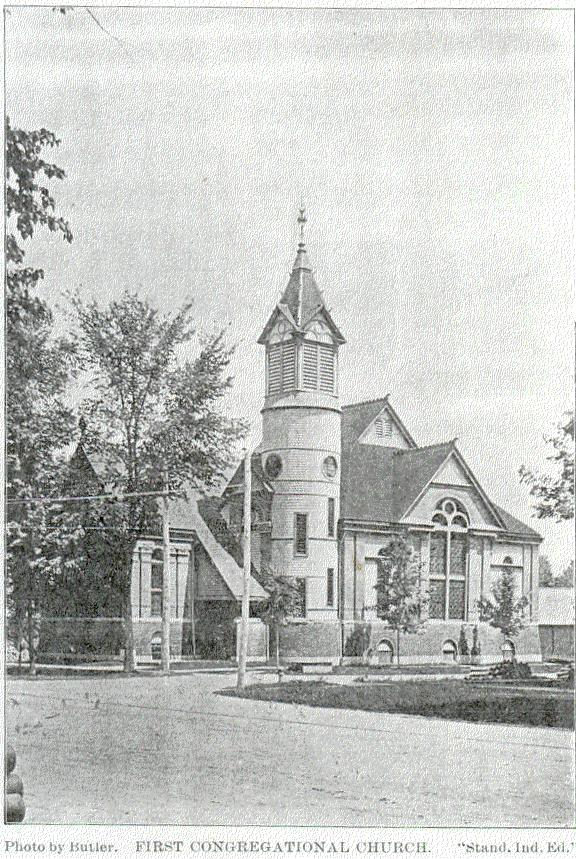
Rev. A. T. Swing for one year and Rev. Edward Taylor, D. D., for more than three years were acting pastors. At the tenth anniversary celebrated during the pastorate of Dr. Taylor, the church report showed that by the addition of a fine organ and various improvements the value of the church property had increased to $30,000 and the church membership stood at 463. Dr. Taylor's personal helpfulness to the church cannot be estimated nor expressed in a report. The last sermon of Dr. Taylor and the first sermon of the incoming pastor, Rev. W. H. Pound, were given on the same day (morning and evening) Nov. 15, 1892. Thus a united people were not divided by a change in pastorate. Mr. Pound soon saw a field for gospel work in a part of the town known as the Eastside. By his untiring efforts, seconded by his church, a Sabbath-school was established and Sabbath services held regularly for a long time. Sabbath school at 3 o'clock, under the efficient care of J. W. Keese is still held and a Woman's Missionary society and Y. P. S. C. E. are in prosperous condition. The regular church services however, are merged into those of the older church and the whole enterprise is considered a "Branch Work." The care of this, with that of the larger church, having combined in the seven years just closed to make Rev. W. H. Pound the oldest---in length of ministry---and one of the busiest and best beloved pastors in the community.
Loyal Circle of King's Daughters.---On Oct. 22, 1888, a few earnest women met together to discuss the feasibility of organizing a Loyal Circle of King's Daughters in Cortland, and as the result of this conference twenty-five names were enrolled, which constituted a charter membership and there are now over four hundred, not including the thirty King's Sons. Much credit is due the King's Daughters for taking the first step toward the establishing of a hospital in Cortland. In April, 1889, $25.00 was set aside for that object and in a short time was increased to $300. In February, 1891, a public meeting was held in its interest and ten days later the Cortland Hospital association was formed. So pressing have become the demands at home that other work has given way almost entirely to local charity. The work is done quietly ever keeping in mind that it is "more blessed to give than to receive." The following are the officers for 1899:---President, Mrs. Henry Relyea; secretary, Mrs. A. A. Sprague; treasurer, Mrs. DeWitt Rose; first vice-president, Mrs. W. H. McKinney; second vice-president, Mrs. M. K. Harris; third vice-president, Mrs. Homer Smith; fourth vice-president, Mrs. George L. Watson; superintendent of local charities, Mrs. Eliza Jones.
Cortland Hospital---It was the Rev. J. A. Robinson, for many years rector of Grace church, who first suggested the idea of a hospital for Cortland. It was Mrs. T. B. Stowell who proposed to the Loyal Circle of King's Daughters, of which she was at the time leader, that it should take the initiative in establishing such a hospital and so enthusiastically was her proposition received and so vigorously acted upon that upon the organization of the Hospital association, Feb. 23, 1891, the Circle transferred to its treasury the sum of $1,300, the result of a series of entertainments and of the solicitation of subscriptions by its members. The hospital was opened April 1, 1891, in a rented cottage on Clayton-ave. with accommodation for six patients. For a time one woman performed the triple duties of matron, nurse and housekeeper, with the assistance of a boy to care for the furnace and walks. During the ten months remaining of that hospital year fifteen patients were cared for. From this small beginning the work has steadily progressed and increased until now at the end of eight and one-half years the working force consists of a matron, nine nurses, two domestics, a laundress and janitor. The record for the year ending Sept. 30, 1899, shows 120 patients treated, an average of over 9 per day, while 52 outside patients were cared for by nurses. In 1895 the association was enabled to purchase and repair the building now occupied which was opened with appropriate dedicatory services March 27, 1895. Five rooms for private patients and the class room have been handsomely furnished by societies or individuals and these have been named in recognition of the generosity of the donors. Two wards, also named for liberal contributors, now have seven beds with room for more as occasion demands.
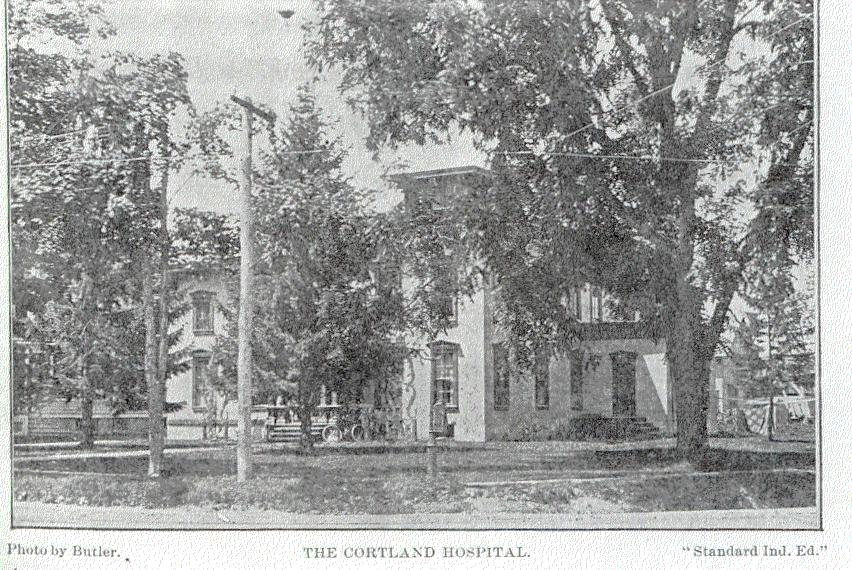
The staff at present consists of the following physicians: Surgical, Drs. Dana, Higgins, Reese, Sornberger; medical, Drs. Didama, Henry, Moore, Neary, Johnson, Nash, Santee, Spaulding and Strowbridge. The present board of managers is as follows: Mrs. A. E. Buck, Mrs. Delos Bauder, Mrs. Ella C. Butler, Mrs. F. H. Cobb, Mrs. W. H. Crane, Mrs. Hugh Duffey, Mrs. Mary E. Doud, Mrs. F. J. Doubleday, Mrs. L. J. Fitzgerald, Miss Mary Goodrich, Mrs. S. N. Holden, Mrs. Julia E. Hyatt, Mrs. E. C. Heath, Mrs. Coleman Hitchcock, Miss Louise Henry, Mrs. A. P. McGraw, Mrs. N. J. Peck, Mrs. W. J. Perkins, Mrs. Aaron Sager. The officers are: Hon. President, Mrs. M. E. Doud; president, Mrs. Julia E. Hyatt; 1st vice-president, Mrs. Delos Bauder; 2d vice-president, Mrs. W. H. Crane; secretary, Mrs. A. E. Buck; treasurer, Mrs. F. H. Cobb. Advisory board: Dr. F. J. Cheney, Mr. E. D. Blodgett, Mr. James Dougherty, Hon. S. S. Knox, Mr. G. J. Mager, Mr. E. C. Palmer, Mr. B. L. Webb, Mr. C. F. Wickwire, Mr. H. M. Whitney. Eight nurses have completed the prescribed course in the training department. The hospital has received legacies from Mrs. Adalenah Rogers, Mrs. Orissa Baker, Mrs. Frances McFarlan and Dr. J. H. Brewer and these with a gift from Mrs. Elisa Rose Palmer, have been used to improve the premises. Other legacies, not yet available, have been received from Mrs. T. A. Price, Mr. and Mrs. H. P. Goodrich and Mrs. Sarah Sturtevant.
The Cigar Makers' Union 116 of Homer, N. Y. was organized in Homer, Aug. 16, 1884, with the following officers: President, Geo. Sanford; vice-president, Theo. Anderson; secretary, Geo. Simmons. In 1891, Union 116 of Homer was transferred from Homer to Cortland and is now doing business with the following officers: President, S. J. Doyl; vice-president, S. Kinney; secretary, Benj. F. Langham.
Cortland Universalist Church.---Universalism was first preached in Cortland county by Nathaniel Stacy, who wrote: "In 1807, on my first visit to Cortland county, I delivered one address at Homer, and one at Port Watson. The latter was a new place but contained as many inhabitants as Homer. There was but one solitary house where the flourishing village of Cortland now (1850) stands, and that one was a residence of a friend of ours by the name Hubbard." (Stacy's Memoirs, page 190.) In the oldest record book of the parish extant, is the following reminiscence written apparently from memory, by the first clerk of the parish, John Chamberlain:
"According to early records of Universalism in Homer, it appears that a society of the name of 'The First Charitable, Universal, Religious Society of the Town of Homer,' was organized at the court house, Homer, (now Cortlandville) the 16th of Nov., 1813. Samuel Ingalls and Mead Merrill presided at the above meeting. The following persons were elected trustees: Moses Hopkins, Allen Barry, John Chamberlain, David Merrick, Mead Merrill, Roger Edgcomb. A society of the name of 'The First Universalist Society of the Town of Homer' was organized Jan. 19, 1829, at the house of David Merrick. The last meeting of the above society was holden on the 18th of Jan., 1831."
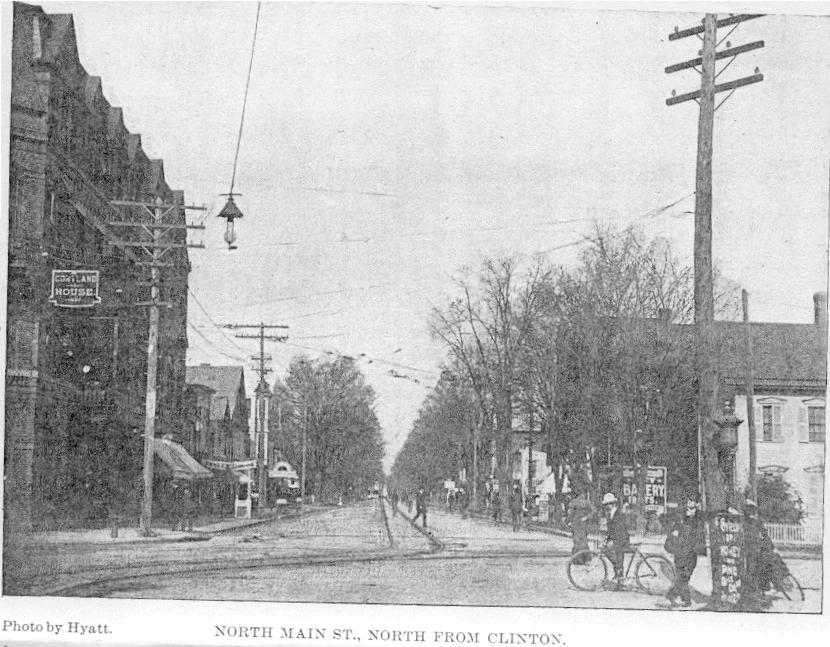
The "House of David Merrick" stood on the present site of the Cortland Opera House. In the early days there seems to have been no settled pastor, services being held occasionally, whenever a preacher came this way. This continued until 1831, when Rev. Nelson Doolittle, settled at Cortland and Homer, as the first permanent pastor. For a number of years services were held on alternate Sundays at these places. His pastorate lasted two years, when Rev. George Sanderson, in 1833, became pastor, and served the church in that capacity for three years. It was during this period that the permanent foundation of the present society was laid. At a special meeting of the parish in the Baptist meeting house, held Sept. 17, 1834, a committee of seven, of which the pastor was first named, was appointed "to draft a new code of by-laws for the benefit of the society." The committee reported the next month; the report was adopted, and arrangements made for a grand meeting when the new Covenant should be signed. The two days' Conference meeting was held in February, 1835. Rev. Dolphus Skinner gives a very interesting account of it in the "Magazine and Advocate" of that year, he preaching two sermons. Nine ministers, whose names he mentions, were present. In conclusion he says: "At the close of the service, the Constitution, Declaration and Covenant were read, and signed by thirty-five sisters and sixty-six brethren, making an aggregate of one hundred and one members." The Baptist meeting house was still used as a place of worship. Late in 1835 or early in 1836 a committee was chosen relative to "building a meeting house." On February 9th, 1836, this committee was empowered "to fix upon the size of the house, form and materials of which it shall be built, the plan of raising the money, and the site where it shall stand." February 23, the committee reported "That the meeting house be built on the lot offered by Calvin Bishop. That the size of the house be 60x44 feet. That the walls be of cobblestone and such other materials as are necessary for the purpose and that the funds be raised by subscription." This was not quite explicit enough, for this was followed by a motion that "the committee agree on a level floor, a gallery on three sides, west, north and south, two tiers of windows, and a desk in the east end of the house." About this time the Rev. Walter Bullard became pastor and served in that capacity for two years, being followed by Rev. A. C. Barry in 1838. During his pastorate the society was re-incorporated, the legal name, "The First Charitable, Universalist, Religious Society of the Town of Homer," was changed to "The First Universalist Society of the Town of Cortlandville." This was done May 7, 1839. The new church was dedicated July 10, 1839. At the annual meeting Jan. 10, 1840, Rev. T. J. Whitcomb was called to the pastorate. The following year his predecessor, Rev. A. C. Barry, wrote in the "Magazine and Advocate" (page 141) regarding this society: "There are now (1841) probably between seventy and eighty members. Their meeting house (the best in the county) is located at Cortland village---the county seat---which contains rising of a thousand inhabitants." On Jan. 11, 1842, Rev. Mr. Whitcomb received twenty-two new members in the church, among them being our honored and beloved deacon, Ebenezer Mudge, the only survivor of that company. We will pass over the pastorates of Rev. Messrs. Charles S. Brown and D. H. Strickland and others, until the year 1857, when the church called to minister to it Rev. William H. Fish. Mr. Fish came as a non-sectarianist. His creed was temperance and the abolition of slavery. His pastorate extended through five years, 1857 to 1862. This was the golden age of the Lyceum and public lectures, and Mr. Fish was the man to make the most of every opportunity. To the platform of this church came Thomas Starr King, Theodore Parker, Henry Ward Beecher, Edward H. Chapin, Charles Sumner, Wendell Phillips, Wm. Lloyd Garrison, Ralph Waldo Emerson and others. With considerable Yankee shrewdness Mr. Fish quite often managed to have the lectures take place on Saturday night, so that the guests would have to remain over Sunday, and the people would have the privilege of two or three more lectures the next day, free of charge. Rev. Mr. Fish's stirring pastorate was followed by the ministrations of the Rev. Stephen Crane, who remained with the church for four years, being followed by Rev. John M. Austin and Rev. F. B. Peck, Rev. E. F. Pember and Rev. H. W. Hand, the latter remaining one year, doing excellent work in the way of reorganization, and furnishing a new set of bylaws. This church has a good constitution else it never could have survived the numerous by-laws!
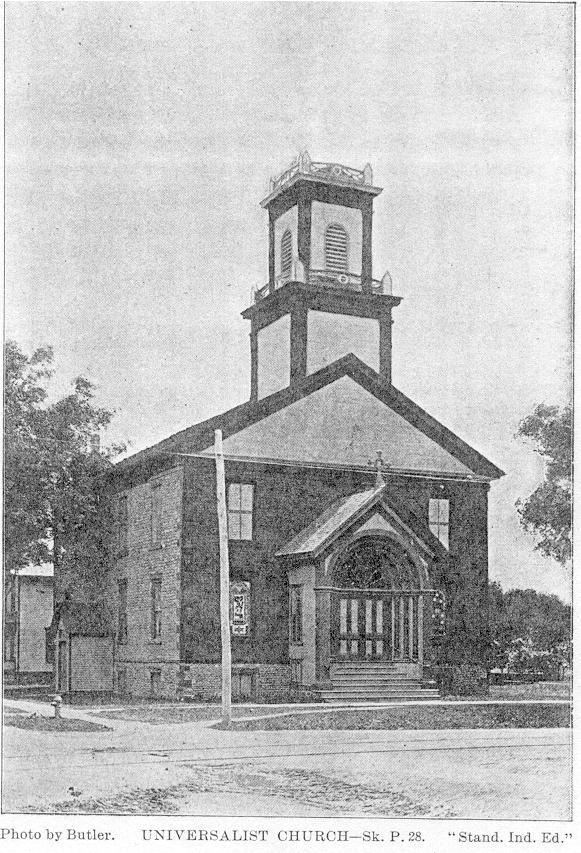
Rev. George Adams was the next pastor, from 1883 to 1886. He was followed by Mr. H. E. Gilchrist, who was ordained in the church. Rev. Ura Mitchell assumed the pastoral duties Feb. 1, 1889. Under his energetic administration the church edifice was entirely remodeled, giving it its present modern appearance in the interior. He was succeeded by H. W. Carr, who graduated from the Canton Theological school in June, 1891, and who assumed the pastoral duties of the church at once, which proved to be a successful and prosperous one, and the longest in the history of the parish. During his pastorate the church was further modernized by placing a new organ in its present position, cutting out the original solid stone wall and building the organ loft. Mr. Carr was ordained to the ministry and married in the church while pastor. Since his resignation the church has had two ministers---Rev. John Kenyon, from April 1, 1897 to Oct. 1, 1898, who was also ordained in the church, and the present pastor, Rev. U. S. Milburn, who commenced his duties Oct. 1, 1898. This church has given to the Universalist ministry four clergymen---Rev. Messrs. A. C. Barry, J. M. Peebles, G. A. Kratzer and H. E. Newton.
The Ladies' and Pastor's Aid Society of the Homer Ave. M. E. church of Cortland was organized Oct. 16, 1890, when the following officers were elected: President, Mrs. A. Sager; vice-president, Mrs. A. W. Watkins; secretary, Mrs. S. E. Curtis; treasurer, Mrs. S. S. Stearns; executive committee, Mrs. Frank Bosworth, Mrs. Bloom La Barre, Mrs. Wm. Moresheimer. The object of the society as set forth in the constitution is to assist the pastor in looking after strangers, new members, the sick and destitute; to develop and employ social activity in all departments of church work and as far as practicable assist in the general interests of the church. The ladies who have served as presidents since the organization are as follows: From Oct. 1890 to Oct. 1892, Mrs. A. Sager; from Oct. 1892 to Oct. 1894, Mrs. S. S. Stearns; from Oct. 1894 to Oct. 1896, Mrs. W. P. Robinson; form Oct. 1896 to Oct. 1897, Mrs. Carrie S. Kelly; from 1897 to present date, Mrs. A. Sager. The following are the present officers: President, Mrs. A. Sager; 1st vice-president, Mrs. S. S. Stearns; 2nd vice-president, Mrs. F. E. Eggleston; secretary, Mrs. Martha Head; treasurer, Miss Effie J. Hallock; executive committee, Mrs. W. H. Dickerson, Mrs. Grant Thomas, Mrs. A. Burnham, Mrs. G. F. Price and Mrs. Alma Snyder.
The Aid Society of the First Baptist church was organized in the year 1881 as the Ladies' Dime and Sewing society. Before the year closed, the name was changed to "All Work Together Society," and on May 15, 1890, the name was again changed to Ladies' Aid Society.
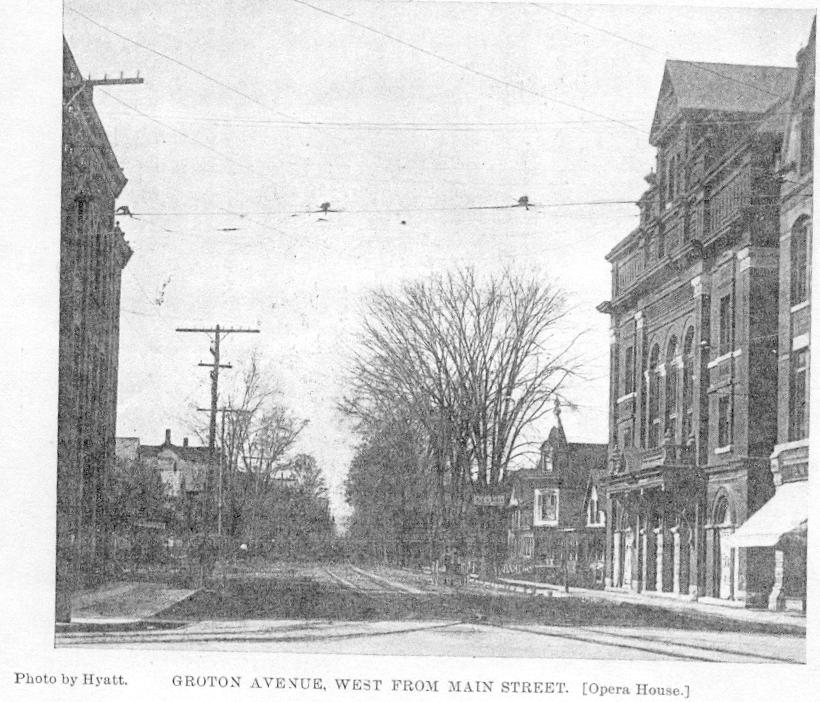
The following were the officers elected when organized: President, Mrs. J. L. Gillett; vice-president, Mrs. O. D. Purinton; secretary, Mrs. G. C. Hubbard; treasurer, Mrs. C. Keator.
The object of this society is to promote mutual acquaintance and fellowship and to raise funds for church purposes. The first year $75 was realized from dime suppers, and the past year, $117. Receipts last year amounted to $480; expenditure, $420.
The following are the present officers: President, Mrs. E. H. Wilson; first vice-president, Mrs. E. O. Perry; second vice-president, Mrs. W. W. Watkins; secretary, Mrs. J. Miller; treasurer, Mrs. Wm. Pearson.
The Sunday-school Missionary Society of the Homer Ave. M. E. church was organized Nov. 30, 1890, with Miss H. C. Henry as president. She tendered her resignation Nov. 1, 1891, on account of leaving town and was succeeded by Miss Helena M. Myers, who held the office until Dec. 1892, when Mrs. H. E. Andrews, the present incumbent, was elected. The object of this society is to create and stimulate interest in missionary work among children and young people. To this end a program is rendered the first Sunday in each month by members of the society. The red letter days are Easter, Harvest and Christmas, when concerts are given and special effort is made in the way of raising funds for this branch of the work. Nearly $1,500 has been raised by the society since its organization.
The Memorial Baptist Church is the outgrowth of a mission that was started by the First Baptist church, in the first ward May 29, 1892. Under the efficient leadership of Dr. F. D. Reese the Sunday-school became so large they outgrew their first quarters, a dwelling house, and a chapel was erected and dedicated Nov. 14, 1893, to which was given the name of Memorial in memory of James Duane Squires, who had been interested in the advancement of the kingdom of God in that section of the village. The church has a number of windows that were given by friends of the chapel in memory of some devout Christian. In 1896 it was thought best by a company of Baptists that lived near the chapel that they should organize themselves into an independent Baptist church. Accordingly letters of dismissal were granted to thirty-five members of the First Baptist church who became constituent members of the Memorial Baptist church. The church was recognized as an independent Baptist church on June 9, 1897. Rev. J. Barton French served as the first pastor from Jan. 1, 1897, until July 1, 1899. The present pastor is Rev. Geo. E. T. Stevenson, a recent graduate of the Divinity school of the University of Chicago, and of Hamilton Theological seminary. During the past year the church has lost two of its very best members in the death of Deacon J. L. Gillet and sister Jane A. Lester, who were among the constituent members. The church is in a flourishing condition at the present time, its membership being eighty-nine. The officers of the Sunday-school are: Superintendent, Geo. Allport; assistant superintendent, J. V. Chatterton; secretary, Miss Belle Allen; treasurer, John S. Miller. The officers of the Woman's Foreign Missionary Circle are: President, Mrs. J. V. Chatterton; vice-president, Mrs. Geo. T. Lester; secretary, Miss Emma Briggs; treasurer, Mrs. Geo. Allport. The officers of the Home Mission society are: President, Mrs. John S. Miller; vice-president, Mrs. Bert Allen; secretary, Miss Emma Briggs; treasurer, Mrs. Frank Byrn. The officers of the Farther Lights society are: President, Miss Minnie Lester; vice-president, Mrs. Will Seaman; secretary, Miss Flora Klotten; treasurer, Mrs. Ednae Klotten. The officers of the Phebe Helpers society are: President, Mrs. J. V. Chatterton; vice-president, Mrs. Albert Klotten, Sr.; secretary, Mrs. John S. Miller; treasurer, Mrs. Geo. T. Lester. The officers of the church: Pastor, Rev. Geo. E. T. Stevenson; deacons, A. H. Allport, F. A. Lombard, I. Dan Lester, Adolph Frost, Jr.; deaconesses, Mrs. Mary E. L. Squires, Miss Emma Briggs; trustees, J. V. Chatterton, W. J. Moss, F. A. Lombard, A. H. Allport, W. H. Scarff, C. E. Wilkins; clerk, Miss Emma Briggs.
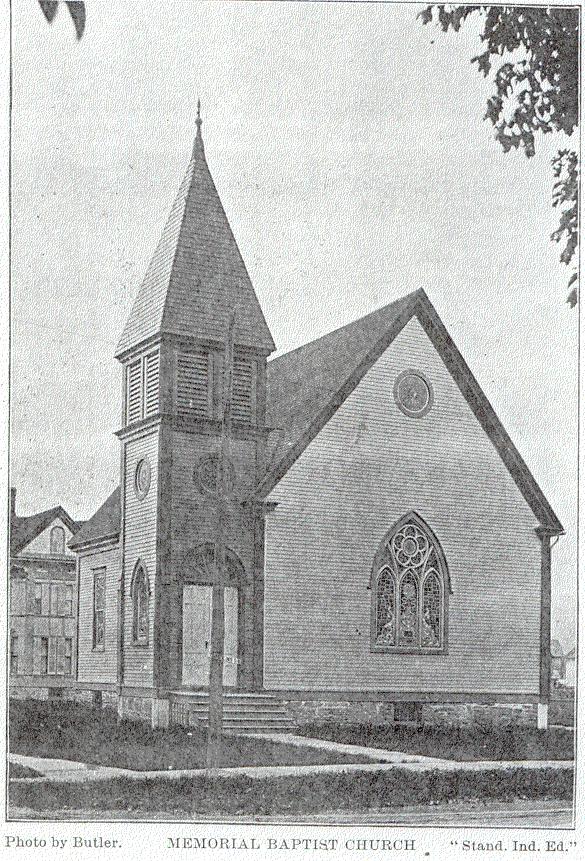
Philopolists.---I discovered Cortland in mid-summer, 1898. I was first impressed with the beauty of the environs, coming south form Syracuse on the D., L. & W. The panorama of hill, tiny lake and valley was so bewitching, that the morning paper lay unread in my lap, while the eye feasted on the stately beauty as we swept along between the wooded slopes. The village itself did not suffer by comparison with the beauty of its approaches. Its straight and clean streets, its luxury of trees, its well kept lawns, its profusion of flowers, its array of churches, its model schools, its uniformity of "respectable" appearance, its comparative lack of hovels, its appearance of diffused culture, its busy shops, its bustling thoroughfares,---all these combined, tend to deeply impress a stranger of the beauty and prosperity of the place. There is found no street, section or ward given over to hovels, poverty, dirt, squalor, viciousness. These are conspicuous by their absence. This was the first impression. A residence of over a year has strengthened rather than weakened that impression. Some new beauty is always revealing itself; some new item in its favor is constantly being manifested. Its streets are more beautiful, its shops busier. But this is all external. An acquaintance with the people reveals them to be cultured, refined, intelligent. Education seems to be quite generally diffused, and not confined to a particular class or clique. As witness of this the large number of clubs and societies organized for purely literary and educational purposes bear testimony. Cortland has its evils, its faults, its shortcomings, many of which could be remedied, but take it all in all it has fewer of these than the majority of places of similar size. The most of its citizens, however, are public spirited, and are working for the best interests of this little city. They can truly be called "Philopolists." For beauty, for prosperity, for its social life, for its intellectual status and moral standing Cortland would certainly take its place in the very front ranks among the smaller cities of the Empire State. He who has capital to invest, who has children to educate, who wishes to live a quiet and retired life amidst elevating surroundings, would find Cortland a profitable and suitable place to pitch his tent.---U. S. MILBURN.
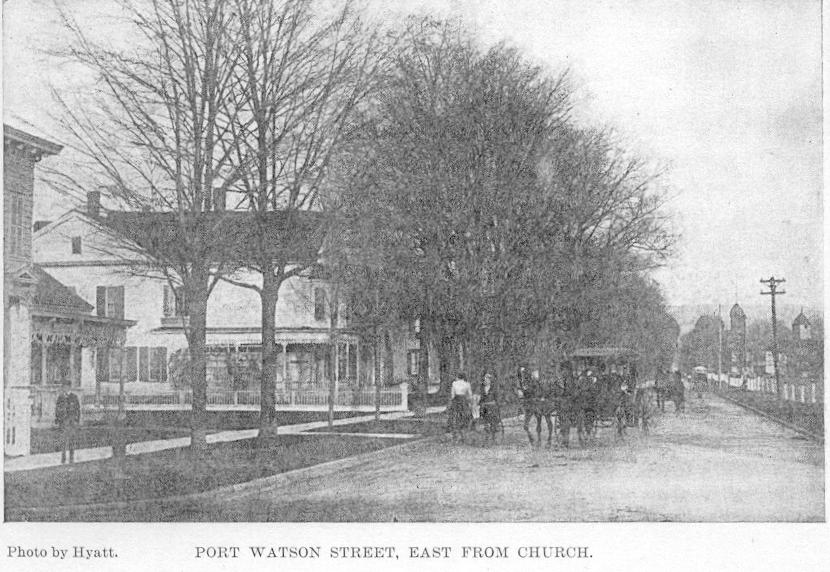
The Ladies' Literary Club of Cortland was an outgrowth of a Book Club organized two years previously. A half dozen ladies especially interested in the study of literature called a preliminary meeting of all the book club members who wished to study literature and authors in a systematic and regular manner. Ten ladies responded and the first meeting was held at the home of Mrs. Wm. P. Randall, March 24, 1880, for the purpose of organizing a club. Mrs. Jennie Crandall was made chairman and the following permanent officers were elected: President, Mary F. Hendrick; vice-presidents, Mrs. Jennie Crandall and Mrs. Mary B. Stowell; secretary, Miss Editha Stephens; treasurer, Mrs. L. K. Shankland. Mrs. Crandall, Mrs. Stowell and Mrs. Ella (Hubbard) Apgar were appointed a committee to draft a constitution and by-laws. From that date to the present the meetings have been held regularly with scarcely an exception. So well and so wisely was the original work done that the constitution and by-laws have remained essentially unchanged during the nearly twenty years of the club's existence. The number of members was limited to thirty. Of the charter members but four or five remain, while one hundred different names are enrolled upon its list. As the years have passed a large amount of work has been achieved. The special committees have been untiring in their efforts to arrange the subjects in such a manner as to combine the instructive with the agreeable. The years of 1891 and 1892 were spent in studying history, geography, manners and customs, art and literature of foreign countries, illustrated with an occasional stereopticon evening, or a professional lecture, while 1893 was given to preparation for the proper enjoyment and appreciation of the great gathering of the nations at the World's fair. During 1894 and 1895 special study was given to American authors, which may be counted among the most valuable of the work done. Each quarter's work closes with an entertainment of some kind. To the literary program has been added the department of current topics. We do not exclude the social element. Once a year the president lays aside the gavel, forgets the dignity of her official position and gives us an afternoon in which we do up the visiting for the year or are amused and entertained as she sees fit. These are called "president's days" and in the words of the ever joyous Shakespeare, "it is very reverend sport truly, and done in the testimony of a good conscience." The officers for the present year are: President, Mrs. Grace C. Walrad; 1st vice-president, Mrs. Kittie Higgins; 2nd vice-president, Mrs. E. M. H. Johnson; secretary and treasurer, Miss Mary Goodrich; corresponding secretary, Mrs. C. W. B. Cornish. The members are: Miss M. Minerva Adams, Miss Alida Cornelia Adams, Mrs. Helen J. Apgar, Mrs. Clara H. Banta, Mrs. Mary M. Beach, Miss Clara e. Booth, Mrs. Mary Alta Chambers, Mrs. Arabella B. Collins, Mrs. C. W. B. Cornish, Miss Marguerite Force, Miss Ella Gale, Mrs. Caroline R. Gillette, Miss Mary Goodrich, Miss Mary F. Hendrick, Mrs. Mary F. Henry, Mrs. Kittie Higgins, Mrs. Lillian C. Jayne, Mrs. E. M. H. Johnson, Mrs. Hattie B. Mudge, Mrs. E. A. Nash, Mrs. Louise M. Foote, Mrs. Florence C. Reese, Miss Martha Roe, Miss Miriam S. Skidmore, Mrs. Mary B. Smith, Mrs. Kate F. Sornberger, Miss Editha Stephens, Mrs. Julia Jarvis-Twiss, Mrs. Grace C. Walrad, Mrs. M. M. Watrous.
Rev. Ulysses Sumner Milburn, pastor of the Universalist church, was born in the little hamlet of Black Lick, ten miles east of Columbus, Ohio, December 16th, 1865. He attended the district schools of that state and for three years taught in the same schools. His thoughts were early inclined toward the profession of ministry, and to prepare himself for that work he entered the Divinity school of the St. Lawrence University, Canton, New York, from which institution he was graduated in 1891. At London, Ohio, he was ordained in October of the same year, and preached there for sixteen months when he was called to Baltimore, Md., as associate pastor of the Second Universalist church, his co-worker being Rev. Royal H. Pullman, D. D. He remained in that position for about a year and a half, when he became pastor of the First Universalist church of Cincinnati. For over four years he performed the arduous duties as pastor of a large city parish, the society during that time erecting a handsome stone church, and also a business block costing $20,000.00 on a lot owned by the church. In October, 1898, he came to Cortland.
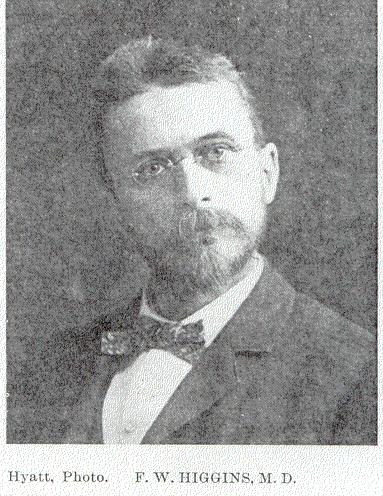
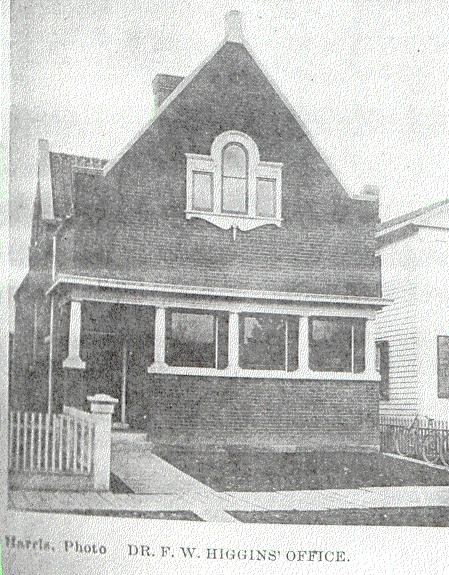
F. W. Higgins, M. D., is the son of a Methodist minister and was born Feb. 7, 1857, in Plymouth, Chenango Co., N. Y. After he was 14 years old he supported himself by farm work, clerking and teaching country schools until prepared to practice medicine. He was educated at the public schools, at Cazenovia seminary and Colgate academy, Hamilton. Before his graduation he was for two years principal of the McGraw academy. He studied medicine with Dr. H. C. Hendrick of McGraw and attended medical lectures at Michigan university, Ann Arbor and the Medical Department of the University of the City of New York. He was graduated from the latter institution in 1881, and began the practice of medicine in that same year with the late Dr. J. C. Nelson of Truxton. For four and one-half years he remained in Truxton, then moved to Chemung, Chemung county, where he practiced for a year and a half, and in the spring of 1887 came to Cortland, which has since been his home. In preparation for practice in diseases of the eye, ear and throat he has taken post-graduate work in the hospitals in New York and Philadelphia. He also spent two months in London, in the summer of 1894, working in hospitals under the instruction of eminent specialists. Dr. Higgins is a member of the Cortland County Medical society and was for several years its secretary. He is also a member of the New York State Medical association, the American Medical society, and the Medical Association of Central New York. He was married on Nov. 26, 1879, to Miss Kittie M. Smith of McGraw. They have four children---three sons and one daughter, viz.: R. Paul, a student at Cornell; Max S. and George H. and Winifred A., who are living at home. Dr. Higgins was elected president of Cortland village in 1895 and served one term.
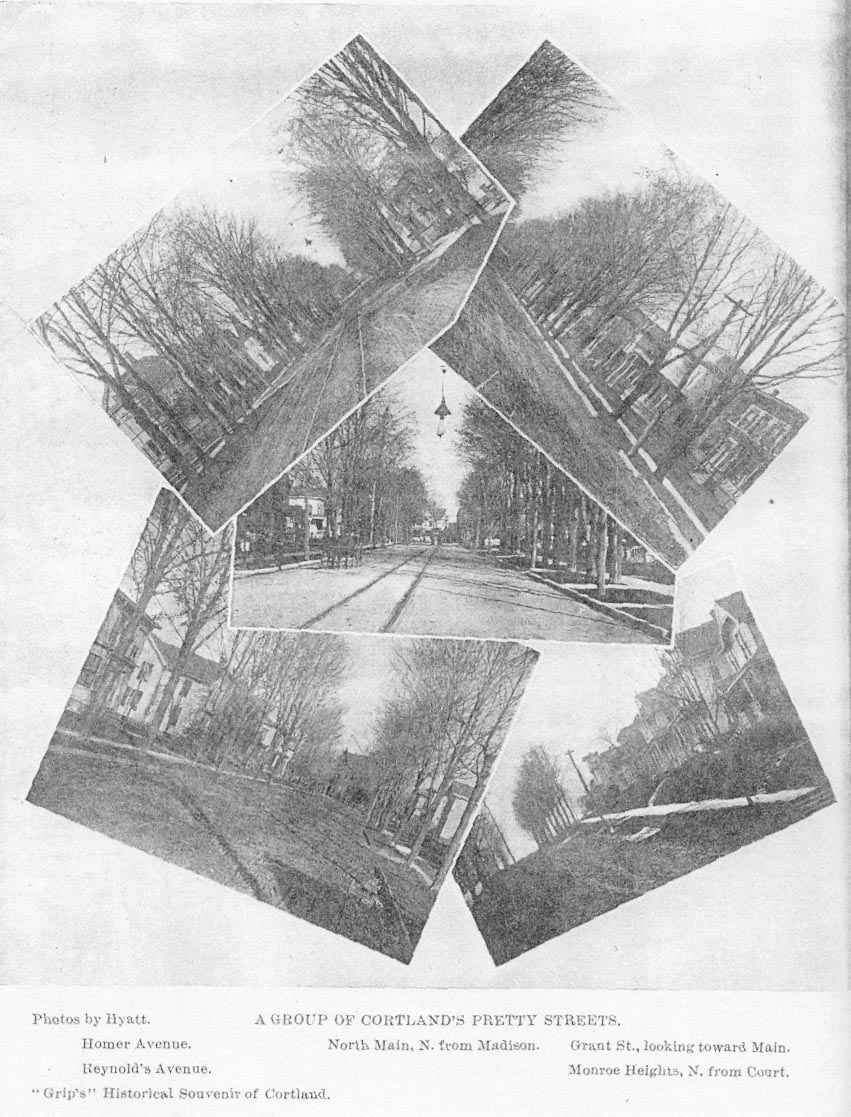
You are visitor since 28 Aug 2011 -- thanks for stopping by!
There were 2198 visitors to our previous host from 4 Nov 2005 to 28 Aug 2011.
© 2005-2011
Grip's Souvenir
Town of Cortlandville
Other Towns
Cortland Co, NY Site